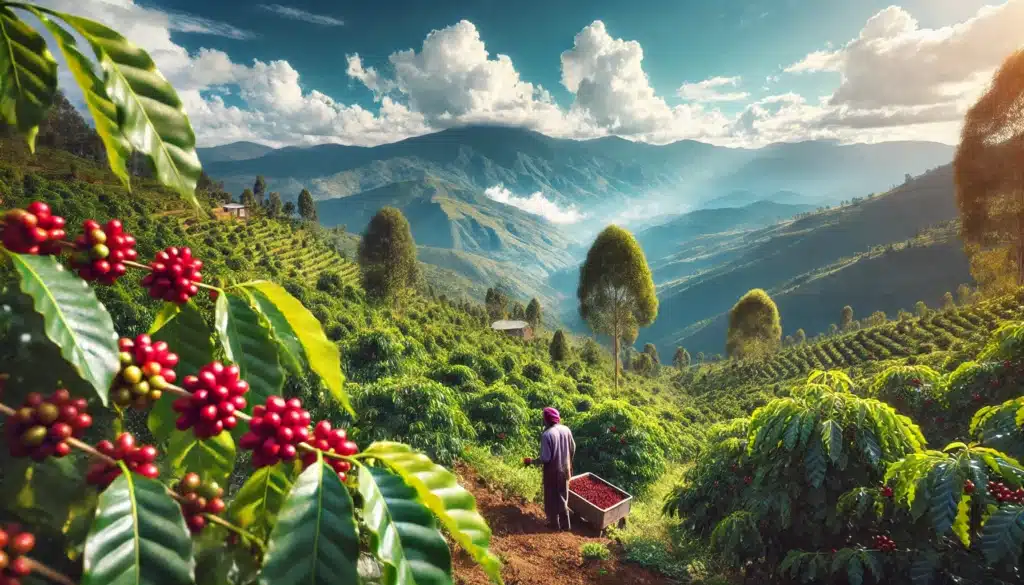Altitude is one of the most influential factors in determining a coffee’s flavor. The higher the coffee is grown, the more time the beans have to develop complexity — and the more likely you are to taste vibrant acidity, floral aromatics, and a clean finish.
In this article, we explore how altitude affects the chemistry of coffee, why it matters to producers and roasters, and how to identify altitude-driven flavors in your cup.
1. What Altitude Means in Coffee
When we talk about altitude in coffee, we’re referring to the elevation (in meters or feet above sea level) at which coffee trees are cultivated.
Common ranges include:
- Low altitude: below 900 meters (3,000 ft)
- Mid-altitude: 900–1,200 meters (3,000–4,000 ft)
- High altitude: above 1,200 meters (4,000 ft), often reaching 2,000+ meters in places like Ethiopia or Colombia
Higher altitudes generally mean cooler temperatures, which slow down the bean’s growth cycle.
2. Slow Maturation = More Flavor
At higher elevations, cooler temperatures delay cherry ripening. This slower maturation allows more time for:
- Sugar development
- Acid formation
- Complex aromatic compounds
The result? Coffees with brighter acidity, fruity or floral notes, and a cleaner finish — highly prized in the specialty world.
3. High-Altitude Coffee Profiles
Coffees grown at higher altitudes tend to show:
- Citrus or berry-like acidity
- Tea-like body
- Floral aromatics
- Distinct clarity and structure
Examples include:
- Ethiopian Yirgacheffe (1,800–2,200m): jasmine, bergamot, lemon
- Kenyan AA (1,600–2,000m): blackcurrant, tomato, bright acidity
- Panama Geisha (1,400–1,800m): jasmine, peach, honey
4. Low-Altitude Coffees: Smooth and Nutty
Coffees grown at lower elevations often develop faster, resulting in:
- Lower acidity
- More chocolate, nut, or earthy notes
- Heavier body, sometimes more bitterness
These beans are often used in espresso blends or mass-market coffee, offering consistency and familiarity.
Examples include:
- Brazil Santos (800–1,000m): cocoa, almond, mild body
- Sumatra Mandheling (750–1,200m): earthy, spicy, full-bodied
5. Altitude and Bean Density
High-grown beans are typically denser due to slower development and thinner air.
This affects roasting:
- Denser beans require more heat and time to roast evenly
- Less dense beans roast faster but may scorch or flatten if mishandled
Roasters often adjust profiles specifically based on bean density, which is closely tied to altitude.
6. Altitude Labels and Specialty Coffee
Many specialty coffee bags include altitude information because it’s seen as a marker of quality.
Labels like “Grown at 1,900 meters” or “SHB” (Strictly Hard Bean) signal that the coffee was cultivated under ideal slow-growth conditions — similar to how wine labels reference elevation or terroir.
7. Challenges of High-Altitude Farming
Growing coffee at high altitudes isn’t easy. Farmers face:
- Steep terrain that complicates harvesting
- Temperature swings that risk frost
- Lower yields per tree
Despite these difficulties, high-altitude farms often produce premium lots that fetch better prices, helping sustain rural economies.
8. Climate Change and Altitude
As global temperatures rise, optimal coffee-growing zones are shifting upward.
Some traditional mid-altitude farms are becoming too hot for quality Arabica, forcing producers to move uphill — if the terrain allows.
This raises concerns about the future of lowland production, especially in regions like Brazil and parts of Central America.
9. Altitude vs. Other Factors
While altitude is important, it’s not the only flavor driver. Other variables include:
- Soil composition
- Rainfall and humidity
- Processing method
- Coffee varietal
For example, a washed Ethiopian coffee from 1,900m will taste different from a natural-processed one from the same farm — even if grown at the same height.
10. How to Taste Altitude in Your Cup
Want to taste the impact of altitude?
- Compare a high-altitude Ethiopian with a lowland Brazilian
- Use a pour-over method to highlight clarity and acidity
- Focus on flavors like citrus, florals, or juiciness — all altitude signatures
Ask your roaster for origin details or try single-origin samplers to train your palate.
Final Thoughts: Elevation, Elevation, Elevation
Altitude isn’t just a number — it’s a flavor engine. It shapes the bean’s journey from seed to cup, affecting sweetness, structure, and elegance.
Whether you’re savoring a bright, high-grown Kenyan or a rich, lowland Sumatra, you’re tasting the landscape itself — lifted by elevation, climate, and the care of the farmer who brought it to life.







